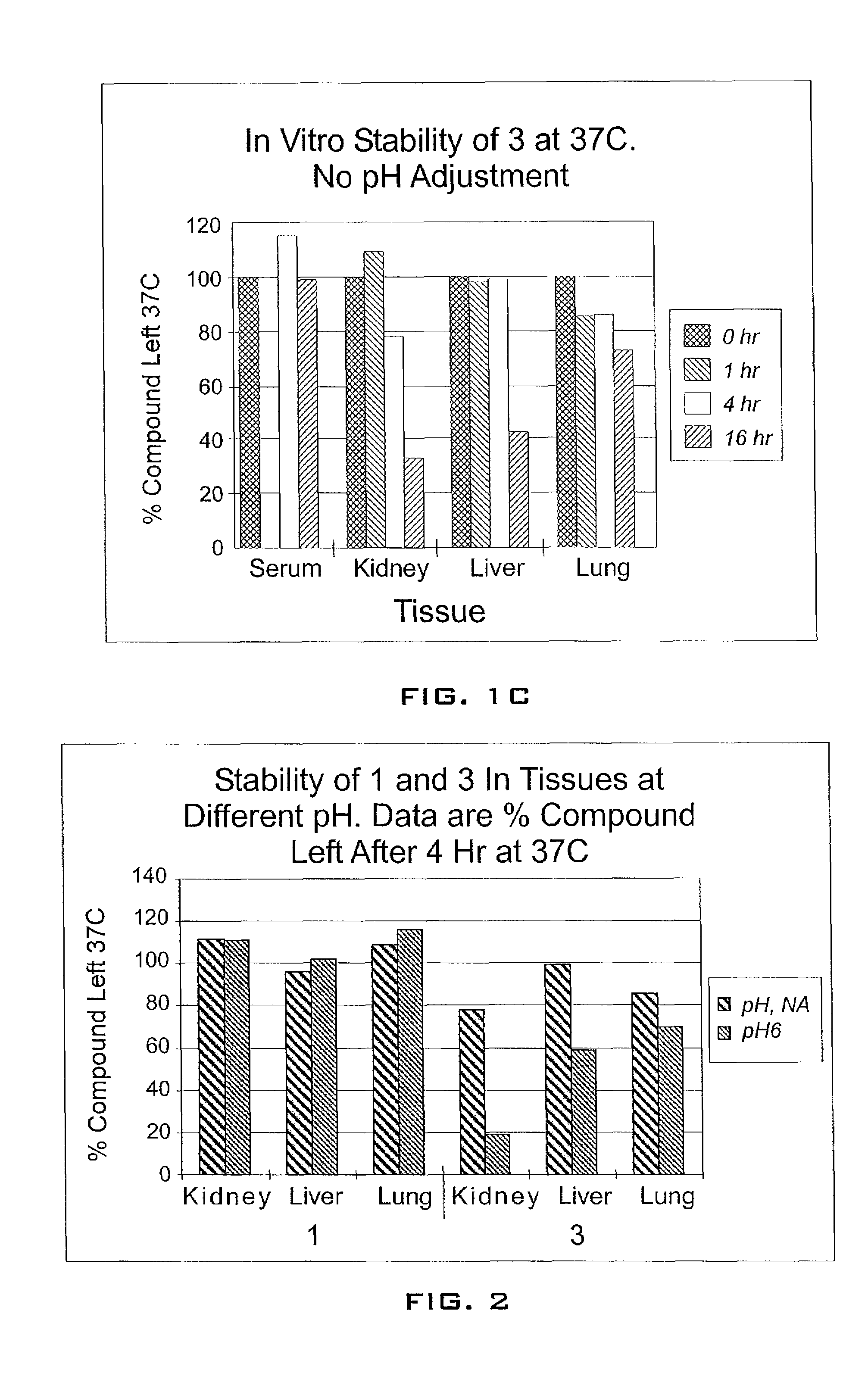Enhancement of tigecycline potency using efflux pump inhibitors
a technology of efflux pump and tigecycline, which is applied in the field of chemistry and medicine, can solve the problems of threatening the clinical utility of antibacterial therapy, high morbidity and mortality, and long patient hospitalization, and achieves the reduction of bacterial resistance to tigecycline, the effect of increasing the killing effect of tigecycline and reducing the emergence of bacterial resistan
- Summary
- Abstract
- Description
- Claims
- Application Information
AI Technical Summary
Benefits of technology
Problems solved by technology
Method used
Image
Examples
example 1
Method F
2-(S),5-Diamino-pentanoic acid [3-phenyl-1-(R)-(4-phenyl-thiazol-2-ylcarbamoyl)-propyl]-amide mono-methanesulfonate (Compound 59)
(A) D-Homophenylalanine Benzyl ester Tosylate
[0597]A solution of D-Homophenylalanine hydrochloride (1.7 g, 7.93 mmol), benzyl alcohol (7.2 mL, 64.0 mmol) and p-toluenesulfonic acid monohydrate (1.8 g, 9.5 mmol) in benzene (30 mL) was heated at reflux in Dean Stark apparatus during 5 hrs, after which time additional benzene (100 mL) was distilled from reaction mixture. The residue was triturated with diethyl ether, the solid was filtered and dried to give title product (2.93 g).
[0598]1H NMR (DMSO-d6) 2.00-2.08 (m, 2H), 2.28 (s, 3H), 2.50-2.57 (m, 1H), 2.66-2.74 (m, 1H), 5.25 (dd, J=17 Hz, J=12 Hz, 2H), 7.10-7.49 (m, 9H), 8.42 (brs, 3H)
(B) NαNδ-bis-Boc-L-Ornithyl-D-Homophenylalanine Benzyl ester
[0599]D-Homophenylalanine Benzyl ester Tosylate (2.48 g, 5.6 mmol) was suspended in ethyl acetate (25 mL) and a saturated solution of sodium bicarbonate in wa...
example 2
Method Ha
2-(S),5-Diamino-pentanoic acid [3-phenyl-1-(R)-(quinolin-3-ylcarbamoyl)-propyl]-amide mono-methanesulfonate (Compound 3)
(A) N-Boc-D-Homophenylalanine Quinoline-3-amide
[0607]A solution of N-Boc-D-Homophenylalanine (3.0 g, 10.7 mmol) in ethyl acetate (100 mL) was treated with 3-aminoquinoline (3.08 g, 21.4 mmol) followed by dicyclohexylcarbodiimide (2.31 g, 11.2 mmol). The reaction was stirred at 25° C. for 3 hr (HPLC monitoring RP-18, 250×4 mm, water:acetonitrile:triethylamine:acetic acid=500:500:0.6:1 (mL), UV detector, λ=254 nm), filtered and the filtrate washed with 1M hydrochloric acid (25 mL), saturated solution of sodium bicarbonate (25 mL) and water (25 mL). The organic layer was dried over anhydrous sodium sulfate, filtered and concentrated to dryness to afford title compound (4.3 g) as white solid.
[0608]1H NMR (DMSO-d6) 1.40 (s, 9H), 1.90-2.05 (m, 2H), 2.58-2.78 (m, 2H), 4.15-4.17 (m, 1H), 7.15-7.33 (m, 6H), 7.54-7.58 (m, 1H), 7.61-7.66 (m, 1H), 7.93 (t, J=9 Hz, 2H)...
example 3
Method Hb
4-(S)-Aminomethyl-pyrrolidine-2-(S)-carboxylic acid [3-phenyl-1-(R)-(quinolin-3-ylcarbamoyl)-propyl]-amide mono-methanesulfonate (Compound 15)
(A) D-Homophenylalanine Quinoline-3-amide
[0616]N-Boc-D-homophenylalanine Quinoline-3-amide (2.6 g, 6.42 mmol, procedure 1A) was treated with trifluoroacetic acid (15 mL) at 25° C. for 1 hr. The solution was concentrated to dryness and treated with diethyl ether (10 mL). The solid was filtered and dried. It was dissolved in water (180 mL) and neutralized to pH=7.5 with saturated solution of sodium bicarbonate. The mixture was stirred for 1 hr and the solid was filtered and dried giving the title compound (1.30 g) as white solid.
[0617]1H NMR (DMSO-d6) 1.76-1.85 (m, 1 H), 1.99-2.08 (m, 1H), 2.65-2.81 (m, 2H), 3.44 (dd, J=8 Hz, J=5 Hz, 1H), 7.15-7.31 (m, 6H), 7.54-7.58 (m, 1H), 7.62-7.66 (m, 1H), 7.91-7.96 (m, 2H), 8.75 (d, J=2 Hz, 1H), 8.99 (d, J=2 Hz, 1H)
(B) N-Boc trans-4-(N-Boc aminomethyl)-L-Prolinyl D-Homophenylalanine Quinoline-3 am...
PUM
| Property | Measurement | Unit |
|---|---|---|
| pH | aaaaa | aaaaa |
| concentration | aaaaa | aaaaa |
| concentration | aaaaa | aaaaa |
Abstract
Description
Claims
Application Information
 Login to View More
Login to View More - R&D
- Intellectual Property
- Life Sciences
- Materials
- Tech Scout
- Unparalleled Data Quality
- Higher Quality Content
- 60% Fewer Hallucinations
Browse by: Latest US Patents, China's latest patents, Technical Efficacy Thesaurus, Application Domain, Technology Topic, Popular Technical Reports.
© 2025 PatSnap. All rights reserved.Legal|Privacy policy|Modern Slavery Act Transparency Statement|Sitemap|About US| Contact US: help@patsnap.com



